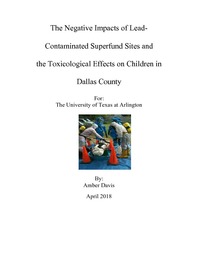| dc.description.abstract | This Study was conducted to investigate the toxicological effects of lead on children, from the age of 0 years old to 18 years old, that reside or attend schools, located within the 5-mile radius, of lead contaminated Superfund Sites, in Dallas County. The toxicological and cognitive effects on children were measured by investigating the unduplicated counts of elevated childhood blood lead levels, from the Year 1999 to the Year 2002, the percentage of schools’ standardized test passing rates, from the Year 1994 to the Year 2002, and the socioeconomic indicators, from the Year 1999 to the Year 2002, for the children that reside within the 5-mile radius, of each Superfund Site; by comparing the same data with children, that reside or attend schools, located greater than the 5-mile radius of each Superfund Site. This study aims to determine the long-term effects, of childhood lead exposure and related cognitive effects, on school standardized test passing rates. Based on the results this study, the unduplicated counts of elevated childhood blood lead levels are significantly higher for the children that reside, within the 5-mile radius of each Superfund Site, than the unduplicated counts of elevated childhood blood lead levels, of children that reside, greater than the 5-mile radius of each Superfund Site. The standardized test passing rates are significantly lower, for the schools that are located, within the 5-mile radius of each Superfund Site, than the schools located greater than the 5-mile radius, of each Superfund Site. There were strong significant relationships between proximity of the children that reside, and the schools that are located, within the 5–mile radius of each Superfund Site, and the unduplicated counts of elevated childhood blood lead levels and standardized test passing rates. In addition, there were strong significant relationships between socioeconomic indicators of low economic status and counts of elevated blood lead levels and percentages of standardized test passing rates. | |


